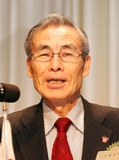��Epoch-making Discovery of Buddhist Statues at Angkor Wat��
January 20, 2010
Mr. Yoshiaki Ishizawa
President of Sophia University
 ��I have been visiting Cambodia to train successors for my Cambodian friends who lost their life during Pol Pot regime. As universities undertake human resource development, I am engaged in the same duty both in Japan and in Cambodia.
��I have been visiting Cambodia to train successors for my Cambodian friends who lost their life during Pol Pot regime. As universities undertake human resource development, I am engaged in the same duty both in Japan and in Cambodia.
��Angkor Wat is a gigantic stone-built Buddhist temple, with high-rising pinnacles, huge cloisters and long approach that fill us with feelings of awe. Cambodia was dragged into the Vietnam War, which ruined Angkor Wat ruthlessly. I was shocked to find many of my Cambodian colleagues missing or dead when I returned in 1980, and I decided myself to protect these historical remains on their behalf.
��Sophia University International Mission of Angkor has worked to conserve, restore, and research Angkor Wat in collaboration with the Cambodian government since 1981, before diplomatic relations were established. As domestic conditions came to stabilize, the UN started its conservation, so did other governments and organizations.
��I visited Phnom Penh in 1991, still under civil war, and trained students of art colleges for three years at Angkor Wat. Then I brought these students to Sophia University to study for their degrees, which are required for research of cultural heritage. All the students, 7 with Ph.D. and 13 with master��s degree, returned to Cambodia, who became frontrunners in restoring historic sites in Cambodia. Today, second and third generation students are being trained. In 1996, Sophia University Angkor Training Center (now Sophia Asia Center for Research and Human Development) was established to train mid-level personnel.
��Tourists visiting Angkor Wat or Angkor Tom are fascinated by its precision and superb skill of stonework which allows not a single blade between stones and overwhelmed with masons�� enthusiasm.
��We have worked with a wish to conserve Angkor Wat, the precious cultural heritage of mankind. We conducted on-site training to conserve and restore the approach of Angkor Wat. This 15-year-project (1993-2007) trained around 30 Cambodian stonemasons. Archaeological excavation trainings were also conducted regularly, three times per year from 1991 to 2000 at Banteay Kdei located 6 kilometers northeast of Angkor Wat, a temple constructed at the end of 12th century.
��On our 31st excavation (March 2001) and 32nd excavation (August 2001), we made a spectacular discovery of excavating a massive number of 274 Buddhist statues, a clear evidence of anti-Buddhist movement estimated to have taken place during the mid-13th century. This discovery taught us there was a king who ordered to abolish Buddhism towards the end of the dynasty. Our discovery also provides an epoch-making ground of argument over ��why did the Angkor dynasty fall?�� The Ecole française d��Extrême-Orient has insisted that the dynasty became impoverished by constructing too many temples and fell when the Kingdom of Ayutthaya attacked several times during the mid-14th century. Our Sophia University Angkor International Mission concluded, based on our discovery, that the king maintained sound dominance till the closing period of his dynasty, but was overthrown by the Ayutthaya military forces.
��Angkor Wat is a city with an efficient water system. Water reservoirs called baray stored water during the rainy season, which enables two-crop or three-crop harvestings even without a raindrop during the dry season. Angkor Wat was constructed about 800 years ago, with the central pinnacle of 65-meter-high and four towers symbolizing the peaks of the Himalayans.
��Suryavarman II, the constructor of Angkor Wat, is engraved on the mural along the cloister, together with as many as 2,352 statues of goddesses.
��In 1952, the approach collapsed by torrential rain and we worked on its reparation by training local Cambodians who covered the cave-ins with soil. It took eight years to train qualified masons. It might seem to be a time-consuming process, yet skilled Cambodians become immediate assets for restoration. The Japanese master mason (Mr. Kosugi) trained about 30 masons in the scorching climate of 45-50 ��, a demanding duty but a good example of Japanese technology transfer.
��Most of the 274 statues discovered by the Sophia University International Mission were seated statues in meditation guarded by Naga (serpent god). A stone pillar with 1,008 small Buddhas engraved was also discovered.
��All the discoveries we made indicate that a sound political system did function and domestic prosperity was maintained under the governance of Jayavarman VIII (1246-1295), which rewrites the Cambodia-Angkor history.
��I am happy to announce that statues we excavated are on permanent exhibition at ��Preah Norodom Sihanouk Museum,�� thanks to the donations and collaboration by AEON 1% Club. I presume many Rotarians will visit Cambodia next month to attend the Completion Ceremony for the Rotary project, ��Anti-personnel Landmine Clearance in Cambodia.�� I would be happy if you could take your time to visit ��Preah Norodom Sihanouk Museum�� and see the statues.